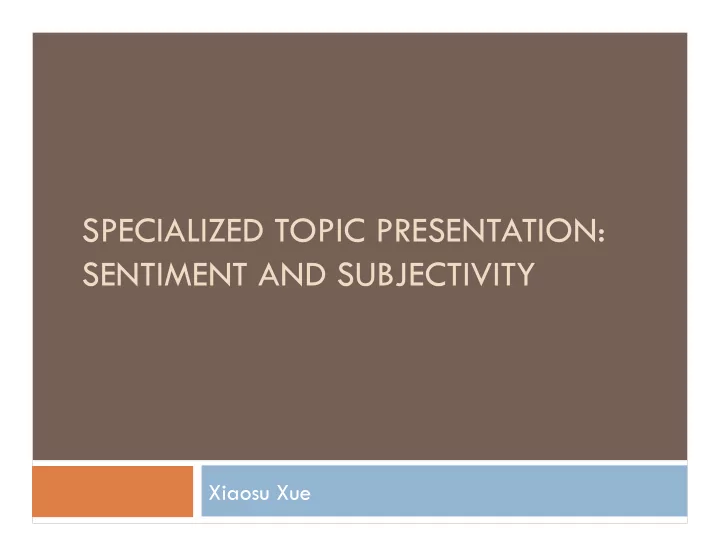

SPECIALIZED TOPIC PRESENTATION: SENTIMENT AND SUBJECTIVITY Xiaosu Xue
The research question ¨ identify when something subjective is being said ¨ recognize the type of subjective content
Annotation schemes looking closely at the problem
MPQA annotation scheme ¨ Key concept: private state ¤ any internal or emotional state ¤ described based on its functional components ¨ Annotation scheme ¤ represented as frames ¤ frames have slots for attributes and properties
Examples of frames
Adaptation of the MPQA scheme ¨ identify subjective questions ¨ no need to represent nested sources ¨ annotate at utterance level
Subjective utterances ¨ “a span of words (or possibly sounds) where a private state is being expressed, either through choice of words or prosody”
Objective polar utterances ¨ positive or negative factual information without expressing a private state
Subjective questions ¨ elicit the private state of the person being asked ¨ three types: positive, negative, general
Sources and targets ¨ marked only on the subjective utterances and the objective polar utterances
Overlapping annotations ¨ the speaker expresses a private state about someone else’s private state
Evaluation
Subjectivity and Polarity Classification work with the data
Goal ¨ recognize subjectivity in general and distinguish between positive and negative subjective utterances
Data ¨ dialogue act segments of AMI corpus ¨ for subjectivity classification: segments overlapping with subjective utterances or subjective questions ¨ for pos/neg classification: segments overlapping with positive or negative subjective utterances
Features ¨ prosody ¨ word n-grams ¨ character n-grams ¨ phoneme n-grams - individual and combined
Results
Results 2
Conclusion ¨ Combined features yield the best results ¨ Prosody seems to be the least informative ¨ Character n-grams seem to perform the best
Sentiment Analysis with prosodic features
Data ¨ elicited short spoken reviews from 84 participants ¤ nine questions asked, but only the final one, the short review, is included in the dataset ¨ 52 positive and 32 negative ¤ mixed reviews -> negative ¤ overall ranking of 4 or 5 out of 5 -> positive ¤ overall ranking below 4 -> negative
Data 2 ¨ for text-based classification: ¤ subjects read a review online, write down a short summary, and indicate the overall sentiment; only reviews originally rated under 2 or above 4 were presented ¤ 3268 textual review summaries: 1055 negative,1600 positive, 613 mixed
Text-based classification baseline ¨ trained an SVM classifier on the full corpus of 3268 textual review summaries ¨ feature: n-grams (n=1,2,3)
Speech recognition ¨ ASR language model trained on data mined from review websites ¨ word accuracy: 56.8% ¤ most mistakes are due to out of vocabulary proper names
Acoustic features
Results
Conclusion ¨ Features characterizing F0 are informative enough to significantly outperform a majority class baseline without using any textual information ¨ If the utterance’s text is known, prosodic features confuse the classifier ¨ If only ASR hypothesis is known, prosody improves performance over a solely text-based model
Finally…
What I have learned ¨ Possible features for subjectivity and polarity classification of spoken language data ¨ The motivation for research on sentiment and subjectivity in spoken language data ¨ Study of annotation schemes helps dissect a problem and facilitates inter-research comparison ¨ Different ways of collecting and selecting data and the possible effect on the results
Questions for discussion ¨ Difference between multi-party conversations and short spoken reviews: is prosody more informative in a spoken review? ¨ From text to speech: what are the challenges/ advantages in the task of subjectivity detection or sentiment analysis?
Recommend
More recommend